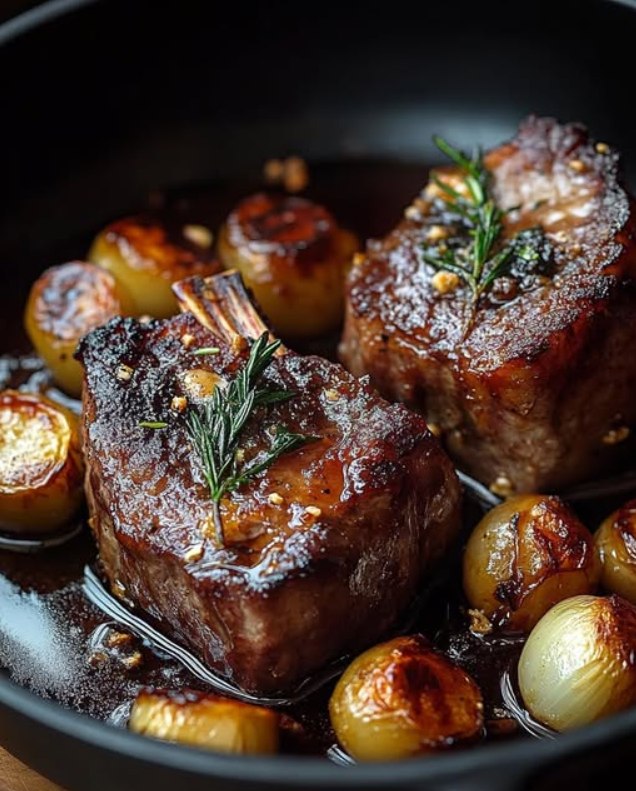Why Slow-Roasted Lamb is a Game-Changer for Your Dinner Table
There’s something magical about the smell of lamb slow-roasting in the oven. It’s like a warm hug for your kitchen and your soul. The first time I made this **Slow-Roasted Lamb**, my family gathered around the table like moths to a flame. The tender meat, infused with garlic, thyme, and a touch of sweetness from caramelized vegetables, was unforgettable. This recipe has become my go-to for special occasions and cozy Sunday dinners. Trust me, once you try it, you’ll be hooked!
A Little History Behind Slow-Roasted Lamb
Slow-roasting lamb is a tradition that dates back centuries, especially in Mediterranean and Middle Eastern cuisines. In France, where this dish originates, “Souris d’Agneau Confites au Four” translates to “oven-confit lamb shanks.” Confit, a French term, means cooking something slowly in fat or its juices, resulting in melt-in-your-mouth texture. While the technique might sound fancy, it’s surprisingly simple. My version brings together classic French flavors with a modern twist, making it accessible for home cooks.
Why You’ll Love This Recipe
This **Slow-Roasted Lamb** is all about deep, comforting flavors and minimal effort. The long, slow cooking process breaks down the tough fibers in the lamb, leaving you with meat so tender it falls off the bone. Plus, the combination of garlic, herbs, and vegetables creates a rich, aromatic sauce that’s perfect for sopping up with crusty bread. Whether you’re a seasoned chef or a beginner, this recipe is foolproof and rewarding.
Perfect Occasions to Make This Dish
This dish is a showstopper for dinner parties, holiday feasts, or even a quiet night in. Imagine serving it at Easter, Christmas, or a birthday celebration. It’s also perfect for those chilly winter evenings when you want something hearty and satisfying. Pair it with roasted potatoes or a creamy gratin, and you’ve got a meal that will make everyone feel loved.
Ingredients You’ll Need
- 4 lamb shanks (souris d’agneau)
- 4 garlic cloves, peeled and crushed
- 2 onions, thinly sliced
- 2 carrots, cut into rounds
- 1 sprig of fresh thyme
- 1 bay leaf
- 250 ml of chicken or vegetable stock
- 3 tablespoons olive oil
- Salt and freshly ground black pepper
Ingredient Substitutions
If you can’t find lamb shanks, beef short ribs work beautifully as a substitute. Swap out the chicken stock for beef broth if you’re using beef. For a vegetarian option, try roasting portobello mushrooms with the same seasoning blend. Fresh thyme can be replaced with rosemary or oregano, depending on your taste. And if you don’t have fresh garlic, use 1 teaspoon of garlic powder instead.
Step-by-Step Preparation
Step 1: Preheat and Prep
Start by preheating your oven to 150°C (300°F). While the oven heats up, pat the lamb shanks dry with paper towels. This helps them brown beautifully later. Grab a large oven-safe pot or Dutch oven—it’s essential for this recipe. Heat the olive oil over medium heat until shimmering. Pro tip: Don’t skip drying the lamb; wet meat won’t sear properly!
Step 2: Sear the Lamb
Place the lamb shanks in the hot oil, one at a time, and sear them until golden brown on all sides. This step is crucial because it locks in the juices and builds flavor. As the lamb browns, your kitchen will fill with a mouthwatering aroma. Once done, remove the shanks and set them aside on a plate. Resist the urge to overcrowd the pan—cook in batches if needed.
Step 3: Soften the Vegetables
In the same pot, add the sliced onions, carrot rounds, and crushed garlic. Cook them until they soften and turn slightly golden. Stir occasionally to prevent burning. Now’s the time to toss in the thym and bay leaf. These herbs will infuse the dish with earthy, fragrant notes. Picture the vibrant colors mingling together—it’s almost too pretty to eat!
Step 4: Combine and Simmer
Return the lamb shanks to the pot, nestling them among the vegetables. Pour in the hot stock, ensuring it reaches about halfway up the shanks. Season generously with salt and pepper. Cover the pot tightly with a lid or aluminum foil. Chef’s tip: Adding a splash of red wine to the stock can elevate the dish to new heights.
Step 5: Roast Low and Slow
Pop the covered pot into the oven and let the magic happen. Roast for 3 hours, turning the shanks every hour to ensure even cooking. The low temperature allows the lamb to become incredibly tender while absorbing all the delicious flavors. After 3 hours, check if the meat is fork-tender. If not, give it another 30 minutes.
Step 6: Serve and Enjoy
Once ready, transfer the lamb to a serving platter and spoon the veggies and sauce over the top. Garnish with fresh herbs if you’re feeling fancy. Serve alongside roasted veggies, mashed potatoes, or a cheesy gratin. Watch as your guests take their first bite and sigh with happiness.
Timing Breakdown
- Preparation Time: 15 minutes
- Cooking Time: 3 hours 30 minutes
- Total Time: 3 hours 45 minutes
Chef’s Secret
For an extra layer of flavor, marinate the lamb overnight with olive oil, garlic, and herbs. This step isn’t mandatory but makes a noticeable difference. Patience truly pays off here!
An Interesting Tidbit
Lamb shanks are often overlooked at the grocery store, but they’re packed with flavor. They come from the lower part of the leg, which is why they’re tougher—but perfect for slow-cooking methods like this one.
Necessary Equipment
- Oven-safe pot or Dutch oven
- Tongs for handling hot meat
- Wooden spoon for stirring
- Measuring spoons and cups
How to Store Leftovers
Let the lamb cool completely before storing it in an airtight container. Refrigerate for up to 3 days. Reheat gently on the stovetop or in the oven to preserve the texture. Freezing is also an option; wrap individual portions in plastic wrap, then place them in a freezer bag. Thaw overnight in the fridge before reheating.
Proper storage ensures the flavors deepen over time. Just think of it as a gift to your future self—a ready-made gourmet meal waiting to happen.
Avoid microwaving leftovers directly from frozen, as it can make the meat rubbery. Instead, thaw first and reheat slowly with a bit of added broth for moisture.
Tips and Advice
- Brown the lamb thoroughly—it adds depth to the final dish.
- Use fresh herbs whenever possible for brighter flavors.
- Don’t rush the cooking process; low and slow is key.
- Taste the sauce before serving and adjust seasoning if needed.
Presentation Tips
- Garnish with fresh parsley or thyme for a pop of color.
- Serve in a rustic wooden bowl for a cozy vibe.
- Add a sprinkle of flaky sea salt just before serving.
- Pair with seasonal sides like green beans or roasted squash.
Healthier Alternatives
Here are six ways to tweak this recipe for a lighter version:
- Leaner Protein: Substitute lamb with turkey drumsticks for fewer calories.
- Vegetable Swap: Use zucchini and bell peppers instead of carrots.
- Low-Sodium Stock: Opt for reduced-sodium broth to control salt intake.
- Olive Oil Spray: Use cooking spray instead of tablespoons of oil.
- Herb Boost: Increase the herbs and reduce the salt for more flavor without sodium.
- Gluten-Free Side: Serve with quinoa or cauliflower mash instead of potatoes.
Common Mistakes to Avoid
Mistake 1: Skipping the Searing Step
Some people skip browning the lamb to save time, but this step is vital for building flavor. Without it, the dish lacks depth. To avoid this mistake, always sear the lamb until deeply golden. It only takes a few extra minutes but makes a world of difference.
Mistake 2: Overcrowding the Pan
Overcrowding leads to steaming rather than browning. Cook the lamb in batches if necessary. Pro tip: Use a larger pot if you’re doubling the recipe.
Mistake 3: Using Cold Stock
Pouring cold liquid into a hot pot lowers the temperature and disrupts the cooking process. Always heat your stock before adding it to the pot.
Frequently Asked Questions
Can I use dried herbs instead of fresh?
Yes, you can use dried herbs, but reduce the amount by half since they’re more concentrated. For example, use ½ teaspoon of dried thyme instead of 1 sprig of fresh thyme.
What should I do if the sauce is too thin?
If the sauce is watery after cooking, remove the lamb and simmer the liquid on the stovetop to reduce it. Alternatively, mix a teaspoon of cornstarch with water and stir it into the sauce to thicken.
Is this dish gluten-free?
Yes, this recipe is naturally gluten-free. Just ensure your stock doesn’t contain hidden gluten additives.
Can I make this in a slow cooker?
Absolutely! Brown the lamb and sauté the veggies on the stove, then transfer everything to a slow cooker. Cook on low for 8 hours or high for 4–5 hours.
How do I know when the lamb is done?
The lamb is ready when it’s fork-tender and easily pulls away from the bone. If it feels tough, it needs more time in the oven.
What wines pair well with this dish?
A bold red wine like Cabernet Sauvignon or Syrah complements the richness of the lamb. For white wine lovers, a full-bodied Chardonnay works too.
Can I double the recipe?
Yes, simply double all ingredients and use a larger pot. Adjust cooking times slightly if needed.
Why does my lamb taste gamey?
Gamey flavors can occur if the lamb isn’t fresh or if it wasn’t trimmed properly. Buying quality lamb and trimming excess fat helps minimize this issue.
Can I add other vegetables?
Of course! Try adding parsnips, celery, or fennel for extra flavor and variety.
How do I reheat leftovers without drying out the lamb?
Reheat gently in the oven with a splash of broth to keep the meat moist. Avoid microwaving, as it can make the lamb tough.
Final Thoughts
This **Slow-Roasted Lamb** recipe is a labor of love that rewards you with incredible flavors and textures. It’s perfect for impressing guests or treating yourself to a comforting meal. With its rich history, simple preparation, and endless versatility, it’s no wonder this dish has stood the test of time. So grab your apron, fire up the oven, and get ready to create something truly memorable. Bon appétit!

Slow-Roasted Lamb
Ingredients
Equipment
Method
- Preheat your oven to 150°C (300°F) and pat the lamb shanks dry with paper towels.
- Heat olive oil in a large oven-safe pot or Dutch oven over medium heat.
- Sear the lamb shanks in the hot oil until golden brown on all sides, then remove and set aside.
- In the same pot, add sliced onions, carrots, and crushed garlic; cook until softened and slightly golden.
- Add the thyme and bay leaf to the vegetables.
- Return the lamb shanks to the pot, pour in the hot stock, and season with salt and pepper.
- Cover the pot tightly and roast in the oven for 3 hours, turning the shanks every hour.
- Check for tenderness; if necessary, roast for another 30 minutes.
- Transfer the lamb to a serving platter, spoon veggies and sauce on top, and serve.
